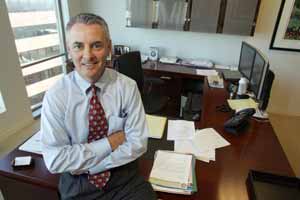
A financial crisis almost certainly isn’t the best time to launch a bank. But it’s worked out pretty well for CapitalSource Bank.
Since opening its doors in mid-2008, just weeks before the stock market nearly collapsed, CapitalSource has quietly increased its profitability, grown its assets and deposits – and suddenly become the fourth largest bank headquartered in Los Angeles County.
And it did all that despite being built from the ruins of Fremont Investment & Loan, a subprime mortgage giant that was one of the area’s biggest casualties of the meltdown.
“They’ve actually done very well since the purchase,” said Scott Valentin, an analyst with Friedman Billings Ramsey & Co. in Arlington, Va. “They’re one of the few banks experiencing good loan growth, decent deposit growth.”
Now headquartered in downtown Los Angeles, CapitalSource has built a somewhat unusual business, catering to specialized companies nationwide such as dentists or nursing homes. The institution has opted not to offer residential mortgages even though it used Fremont, a big home-loan maker, as a platform.
The bank is owned by CapitalSource Inc., a publicly traded former real estate investment trust with roots in the health care industry. The parent company moved this year from Chevy Chase, Md., to Los Angeles in order to be closer to the bank’s branches.
With the abundant capital and industry connections of its parent, the bank has grown its loan portfolio by 31 percent since launching four years ago. CapitalSource now has more than $7 billion worth of loans and other assets.
Unlike many lenders of its size, CapitalSource is not focused on any one community or region, instead making loans across the country. Tad Lowrey, the bank’s 59-year-old chief executive, noted that CapitalSource has lending professionals in 23 states, some working out of their homes.
“We clearly are not a community bank and we’re not trying to be,” he said. “We consider ourselves a nationwide bank. We think nationwide lending is good because it’s diversified by geography.”
Health care background
CapitalSource’s evolution has been an unusual one.
Its parent company was co-founded in 2000 by health care industry veteran John Delaney as a specialty lender to middle-market businesses. After going public, the company in 2006 converted to a REIT – a structure that offered tax benefits.
But in an increasingly shaky economy, CapitalSource’s leaders grew concerned about the stability of funding sources for its loans. So they set out to buy a bank franchise, which could use customer deposits to provide a steady source of money for loans.
After receiving regulatory approval for a bank charter, the company caught wind of an acquisition opportunity in Southern California, which was home to a number of faltering mortgage lenders with large deposit bases.
“The marketplace was somewhat devastated,” said James Barth, a banking expert and senior finance fellow with Santa Monica’s Milken Institute. He said a number of investor groups were drawn to the area, including the private-equity and hedge fund professionals who bought failed mortgage lender IndyMac Bank and rebranded it OneWest Bank.
In 2008, CapitalSource acquired certain assets of Fremont, a subprime lender in Brea that had been driven to bankruptcy by loan losses. Among the purchases, CapitalSource bought Fremont’s deposits and 22 branches. But Lowrey, a banking veteran who was brought on at the time to run the new institution, said CapitalSource was very careful in selecting which parts of Fremont to take on: “We did not buy any of its problem assets.”
Still, the newly formed bank did suffer from its association with Fremont. Lowrey said a number of wary customers pulled deposits early on, particularly since CapitalSource was started just two weeks after IndyMac’s headline-grabbing failure.
“Fremont had been highly troubled, (so) we had a lot of public relations to do,” he said. “We did a really good job of educating the customers.”
The bank took out full-page newspaper ads promoting the institution’s strength and used direct-mail marketing to try to bring back former Fremont depositors.
Meanwhile, the bank endured some initial losses in a loan portfolio acquired from its parent company.
Lately, though, CapitalSource has turned things around. It earned $54 million during the first half of this year and has reported nine consecutive profitable quarters.
With the bank growing, its parent company ceased its commercial finance activities and moved to Los Angeles, which is home to most of CapitalSource’s branches and more than 200 employees. The majority of the bank’s deposits come from California, but that could be changing soon.
Bank leaders hope to expand CapitalSource’s footprint through acquisition if regulatory restrictions lift next year. The bank’s current charter prevents CapitalSource from making acquisitions but Lowrey said the bank expects to convert to a new charter next year that would allow it to do some deals.
“We’re actually looking now, (but) we can’t make any bids on anything until that charter change happens,” he said. “You can look but you can’t touch.”
